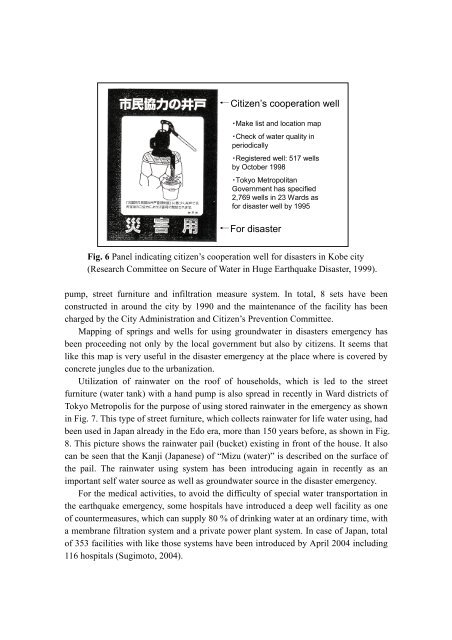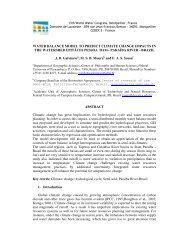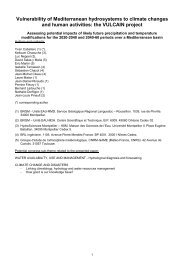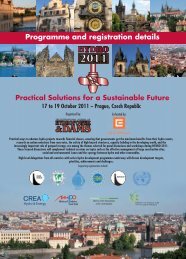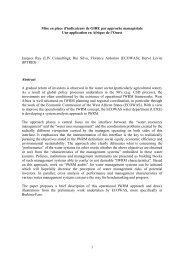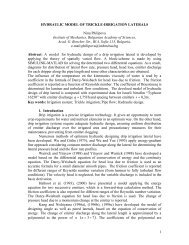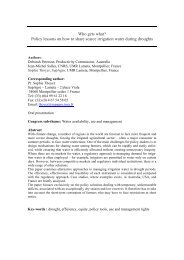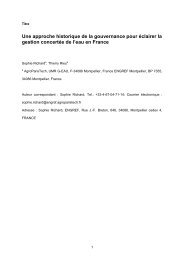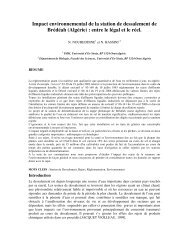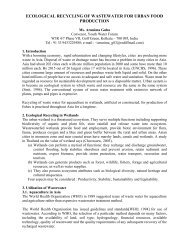Groundwater Use in Earthquake Emergency: A Case Study ... - IWRA
Groundwater Use in Earthquake Emergency: A Case Study ... - IWRA
Groundwater Use in Earthquake Emergency: A Case Study ... - IWRA
Create successful ePaper yourself
Turn your PDF publications into a flip-book with our unique Google optimized e-Paper software.
Citizen’s cooperation well・Make list and location map・Check of water quality <strong>in</strong>periodically・Registered well: 517 wellsby October 1998・Tokyo MetropolitanGovernment has specified2,769 wells <strong>in</strong> 23 Wards asfor disaster well by 1995For disasterFig. 6 Panel <strong>in</strong>dicat<strong>in</strong>g citizen’s cooperation well for disasters <strong>in</strong> Kobe city(Research Committee on Secure of Water <strong>in</strong> Huge <strong>Earthquake</strong> Disaster, 1999).pump, street furniture and <strong>in</strong>filtration measure system. In total, 8 sets have beenconstructed <strong>in</strong> around the city by 1990 and the ma<strong>in</strong>tenance of the facility has beencharged by the City Adm<strong>in</strong>istration and Citizen’s Prevention Committee.Mapp<strong>in</strong>g of spr<strong>in</strong>gs and wells for us<strong>in</strong>g groundwater <strong>in</strong> disasters emergency hasbeen proceed<strong>in</strong>g not only by the local government but also by citizens. It seems thatlike this map is very useful <strong>in</strong> the disaster emergency at the place where is covered byconcrete jungles due to the urbanization.Utilization of ra<strong>in</strong>water on the roof of households, which is led to the streetfurniture (water tank) with a hand pump is also spread <strong>in</strong> recently <strong>in</strong> Ward districts ofTokyo Metropolis for the purpose of us<strong>in</strong>g stored ra<strong>in</strong>water <strong>in</strong> the emergency as shown<strong>in</strong> Fig. 7. This type of street furniture, which collects ra<strong>in</strong>water for life water us<strong>in</strong>g, hadbeen used <strong>in</strong> Japan already <strong>in</strong> the Edo era, more than 150 years before, as shown <strong>in</strong> Fig.8. This picture shows the ra<strong>in</strong>water pail (bucket) exist<strong>in</strong>g <strong>in</strong> front of the house. It alsocan be seen that the Kanji (Japanese) of “Mizu (water)” is described on the surface ofthe pail. The ra<strong>in</strong>water us<strong>in</strong>g system has been <strong>in</strong>troduc<strong>in</strong>g aga<strong>in</strong> <strong>in</strong> recently as animportant self water source as well as groundwater source <strong>in</strong> the disaster emergency.For the medical activities, to avoid the difficulty of special water transportation <strong>in</strong>the earthquake emergency, some hospitals have <strong>in</strong>troduced a deep well facility as oneof countermeasures, which can supply 80 % of dr<strong>in</strong>k<strong>in</strong>g water at an ord<strong>in</strong>ary time, witha membrane filtration system and a private power plant system. In case of Japan, totalof 353 facilities with like those systems have been <strong>in</strong>troduced by April 2004 <strong>in</strong>clud<strong>in</strong>g116 hospitals (Sugimoto, 2004).


